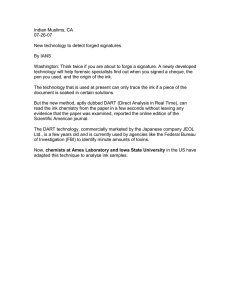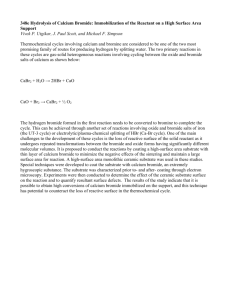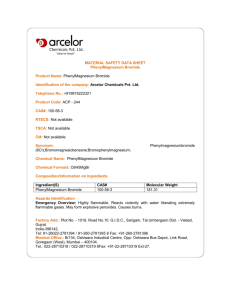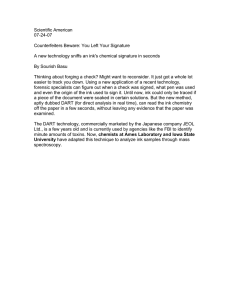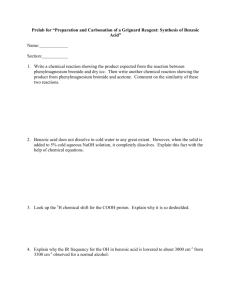T -
advertisement
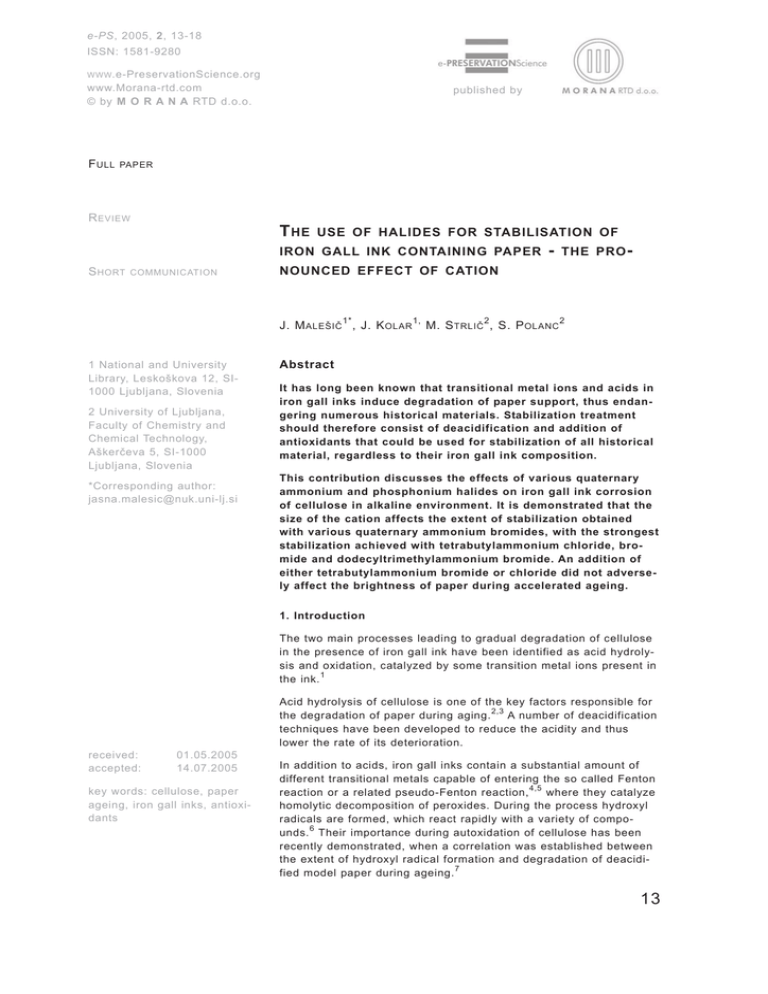
e-PS, 2005, 2, 13-18 ISSN: 1581-9280 WWW.e-PreservationScience.org www.Morana-rtd.com © by M O R A N A RTD d.o.o. F ULL published by PAPER R EVIEW T HE USE OF HALIDES FOR STABILISATION OF IRON GALL INK CONTAINING PAPER S HORT COMMUNICATION 1* 2 University of Ljubljana, Faculty of Chemistry and Chemical Technology, Aškerèeva 5, SI-1000 Ljubljana, Slovenia *Corresponding author: jasna.malesic@nuk.uni-lj.si THE PRO - NOUNCED EFFECT OF CATION J. M ALEŠIÈ , J. K OLAR 1 National and University Library, Leskoškova 12, SI1000 Ljubljana, Slovenia - 1, 2 M. S TRLIÈ , S. P OLANC 2 Abstract It has long been known that transitional metal ions and acids in iron gall inks induce degradation of paper support, thus endangering numerous historical materials. Stabilization treatment should therefore consist of deacidification and addition of antioxidants that could be used for stabilization of all historical material, regardless to their iron gall ink composition. This contribution discusses the effects of various quaternary ammonium and phosphonium halides on iron gall ink corrosion of cellulose in alkaline environment. It is demonstrated that the size of the cation affects the extent of stabilization obtained with various quaternary ammonium bromides, with the strongest stabilization achieved with tetrabutylammonium chloride, bromide and dodecyltrimethylammonium bromide. An addition of either tetrabutylammonium bromide or chloride did not adversely affect the brightness of paper during accelerated ageing. 1. Introduction The two main processes leading to gradual degradation of cellulose in the presence of iron gall ink have been identified as acid hydrolysis and oxidation, catalyzed by some transition metal ions present in the ink. 1 Acid hydrolysis of cellulose is one of the key factors responsible for the degradation of paper during aging. 2,3 A number of deacidification techniques have been developed to reduce the acidity and thus lower the rate of its deterioration. received: accepted: 01.05.2005 14.07.2005 key words: cellulose, paper ageing, iron gall inks, antioxidants In addition to acids, iron gall inks contain a substantial amount of different transitional metals capable of entering the so called Fenton reaction or a related pseudo-Fenton reaction, 4,5 where they catalyze homolytic decomposition of peroxides. During the process hydroxyl radicals are formed, which react rapidly with a variety of compounds. 6 Their importance during autoxidation of cellulose has been recently demonstrated, when a correlation was established between the extent of hydroxyl radical formation and degradation of deacidified model paper during ageing. 7 13 www.e-PRESERVATIONScience.org In addition to iron, iron gall ink contains other transition metals, most notably copper. 1,8 Compared to iron, copper exhibits a superior catalytic activity during Fenton-like reactions. The catalytic effects of iron and copper proved to be additive. 9 increased stability of paper at 20 C by 25-50 times, while KBr and KSCN-treated papers were stabilized to a limited extent and will last up to 3 times longer than the one which was only deacidified. 3 Considering the two cellulose degradation pathways- acid hydrolysis and oxidation, a stabilizing treatment for iron gall ink induced decay requires an addition of alkalis to combat acid hydrolysis of paper and antioxidants to inhibit oxidation. Recently, an extensive study of the production of oxidizing species in model aqueous systems containing pseudo-Fenton reaction mixture and various halides and a pseudo-halide has been performed confirming their antioxidant properties in the presence of both transitional metals usually present in iron gall ink, copper 25 and iron. 26 A variety of antioxidants may be used to interfere with the pathway of oxidative degradation of cellulose. They can be classified into two groups according to the mode of action: those which interrupt the radical chain reaction, i.e. the “chain breaking” antioxidants; and “preventive” ones, which inhibit or retard the formation of free radicals from their unstable precursors, particularly from hydroperoxides. 10 Phytate (myo-inositol hexaphosphate), a complexing agent, which belongs to the “preventive group” of antioxidants has been widely used for stabilization of iron gall ink corrosion. 11 The drawback of complexing agents such as phytate is that they are usually metal-specific. Therefore, we began an extensive survey of antioxidants that could be used for stabilization of all historical materials, regardless of the iron gall ink composition. A selection of antioxidants has been made taking into account possible discoloration of the paper or the ink. Antioxidants should also be stable during the conditions of accelerated ageing and reasonably harmless or non-toxic. Halides such as iodide, bromide and thiocyanate are well known antioxidants which act as radical scavengers. They react with hydroxyl radicals in a wide temperature and pH range. 12-14 The rate constants for reaction of hydroxyl radicals with iodide and thiocyanate ions are nearly diffusion controlled, 14 while the relative rate constants for reaction of hydroxyl radicals with bromide ions are more than ten times lower. 12-15 In acidic solutions, bromide and iodide are also capable of catalyzing heterolytic decomposition of peroxides. 16-18 Potassium iodide has been long recognized as an effective stabilization agent during oxygen bleaching of kraft pulps 19 or oxygen pulping. 20,21 The results presented in the literature demonstrate an effective stabilization of paper in alkaline environment by the addition of iodide, 22,23 thiocyanate and bromide. 24 While iodide and thiocyanate induce discoloration of paper, this was not observed when sodium bromide was added to the paper. 24 Addition of potassium iodide to the Whatman paper containing calcium carbonate 14 o In the present study, evaluation of various halides with respect to their stabilizing effect during ageing of alkaline paper and paper containing iron gall ink is presented. 2. Experimental 2.1 Model paper The model paper sample used was purified cotton linters cellulose (Whatman filter paper no. 1; 86.0 g m -2 , degree of polymerization (DP): 2630 ±0.74%. 2.2 Model inks Two inks, denoted “Ink 0” and “Ink 70”, were used. Both inks were composed of deionised water, 31.4 g L -1 of gum arabic (Fluka, Buchs), 49.2 g L -1 of tannic acid (Riedel de Haen, Seelze) and 0.15 mol L -1 of transitional metal from copper(II) sulphate pentahydrate (Riedel de Haen, Seelze) and iron(II) sulphate heptahydrate (Riedel de Haen, Seelze) in molar ratios Cu(II):Fe(II) ions of 0.0 in Ink 0 or 0.7 in Ink 70. 2.3 Sample preparation Whatman filter paper was immersed for a few seconds into a solution of the selected ink, diluted with a solution of gum arabic (31.4 g L -1 ) in deionised water (1:1 (V/V) ratio for gum arabic solution for Ink 0 and 4:1 ratio for gum arabic in case of Ink 70). Wet samples were then pressed between blotting papers and air-dried. After 1 day of pre-ageing at 70 °C and 50% RH, the samples were immersed for 1 h into a 0.01 mol L -1 aqueous solutions of Ca(HCO ) and air 3 2 dried. Antioxidants were added by immersing the paper samples for 20 min either in an aqueous or a dichloromethane solution of various halides in concentrations as indicated in Table 1. 2.4 Analytical methodology Colourimetric measurements of paper samples were performed with a Minolta CM-3610d diffuse reflectance spectrophotometer with the specular component excluded. The reflectance was meas- Halides for stabilisation of iron gall inks, e-PS, 2005, 2, 13-18 © by M O R A N A RTD d.o.o. Quaternary ammonium bromides Quaternary phosphonium bromides Alkali bromide Quaternary ammonium chloride Chemical name Formula Solvent Tetramethylammonium bromide Tetraethylammonium bromide Tetrapropylammonium bromide Tetrabutylammonium bromide Me4NBr Et 4NBr Pr 4NBr Bu NBr Benzyltributylammonium bromide BnBu 3NBr Dodecyltrimethylammonium bromide (C 12H25)Me3NBr Tetraoctylammonium bromide Tetraheptylammonium bromide Trimethyloctylammonium bromide Tetradecylammonium bromide Tetradodecylammonium bromide Methyltriphenylphosphonium bromide Benzyltriphenylphosphonium bromide Butyltriphenylphosphonium bromide Potassium bromide Tetrabutylammonium chloride (C 8H17)4NBr (C7H15)4NBr Me 3(C8H17)NBr (C 10H21)4NBr (C 12H25)4NBr MePh 3PBr BnPh 3PBr BuPh 3PBr KBr Bu 4NCl H O 2 H 2O H O 2 H O 2 CH2Cl2 H 2O CH2Cl2 H 2O CH2Cl2 CH2Cl2 CH2Cl2 CH2Cl2 CH2Cl2 CH2Cl2 H 2O CH2Cl2 CH2Cl2 H 2O CH2Cl2 4 c -1 (mol L ) 0.03 0.03 0.03 0.03 0.3 0.03 0.03 0.03 0.3 0.03 0.3 0.3 0.3 0.3 0.03 0.03 0.03 0.03 0.3 Solubility (water) + + + + + + + + + + Table 1: Various halides evaluated in the study. Concentration and the solvent used are indicated, as well as their solubility in water (+ soluble and - insoluble). ured relative to Minolta standard. Typical R.S.D. was below ±1% (n = 3). Viscometric determinations of the degree of polymerization were performed according to the standard procedure, 27 using 1 mol L -1 diethylenediaminecupric hydroxide solvent (Carlo Erba) prepared according to the standard procedure. 28 DP was calculated from the intrinsic viscosity measurements using the equation 29 DP 0.85 = 1.1·[ η ]. Typical R.S.D. for duplicate analyses was below ±2%. The rates of cellulose degradation (k) were calculated from DP measurements during artificial ageing using the Ekenstam model 30 . 2.5 Accelerated ageing Two phases of accelerated ageing were carried out on the samples. After the ink had been applied to the paper, the samples were aged for 1 day at 70 °C and 50% RH (pre-ageing). The second phase of accelerated ageing took place after the deacidification and addition of antioxidants. Some samples were aged at 90 °C with a changing relative humidity (RH), cycling between 35-80% RH every 3 h in a Vötsch VC 0020 ageing oven for up to 16 days. Other samples were aged at 80 °C and relative humidity 65% in a Vötsch VC 0020 ageing oven for up to 17 days. 3. Results and discussion Two different model iron gall inks with a Cu:Fe molar ratio 0 (Ink 0) and 0.7 (Ink 70) were applied to a model paper and deacidified with a calcium bicarbonate solution, or deacidified with simultaneous addition of various halides presented in Table 1. Results obtained in model aqueous systems with either iron(III) or copper(II) ions as cat- alyst and halide antioxidants demonstrated that the antioxidant activity depend on the size of the cation introduced with the halide. Regardless of whether Cu(II) or Fe(II) was used, the most pronounced antioxidant activity was exhibited by the quaternary ammonium bromide with the longest alkyl chain. 25,26 3.1 Effect of aqueous treatments with antioxidants First, the effect of various water-soluble quaternary ammonium bromides on iron gall ink corrosion on model papers containing Ink 0 or Ink 70 was evaluated. Results presented in Figure 1 confirm the antioxidant activity of various bromides, as compared to the sample without the added antioxidant. As observed already in model systems in aqueous solutions, 26 the extent of stabilization achievable with water-soluble quaternary ammonium bromides depends on the size of the cation - among the symmetrical quaternary ammonium bromides, tetrabutylammonium bromide was the most effective in the presence of both model inks (Ink 0 and Ink 70). Results obtained on model paper are similar to the ones obtained in aqueous solution also in the antioxidative effect of the halides is more pronounced in the presence of copper ions. Lower degradation rate constants, obtained for samples containing the copper-rich Ink 70, are due the lower concentration of corrosive transition metals in the starting ink. Dodecyltrimethylammonium bromide, which has the longest alkyl chain among the evaluated antioxidants, proved to have the strongest antioxidant activity, when applied on the samples containing Ink 0 (Figure 2). The effect of benzyltributylammonium bromide is similar to the effect of tetrabutylammonium bromide. Halides for stabilisation of iron gall inks, e-PS, 2005, 2, 13-18 15 www.e-PRESERVATIONScience.org Figure 1: Effect of various water-soluble bromides on the degradation rate constant (k) of Whatman filter paper containing Ink 70 or Ink 0 during accelerated ageing (90 °C, RH cycling between 35-80%). Sample A was treated with calcium bicarbonate, other samples were treated with calcium bicarbonate and -1 0.03 mol L aqueous solutions of tetramethylammonium bromide (B), tetraethylammonium bromide (C), tetrapropylammonium bromide (D), tetrabutylammonium bromide (E), benzyltributylammonium bromide (F), dodecyltrimethylammonium bromide (G), methyltriphenylphosphonium bromide (H). Error bars represent standard deviation. 3.2 Effect of non-aqueous treatments with antioxidants In addition to slowing down oxidative decay irrespectively of the transition metal, the advantage of some of the evaluated antioxidants is also their solubility in non-polar solvents, which allows the development of non-aqueous conservation methods. A non-aqueous approach is important due to several disadvantages of the aqueous treatments: possible migration of ink compounds, changes of ink colour and the overall tonal balance of the object, change of dimensions and surface characteristics of paper, necessary dismounting of bound volumes, long drying times. A non-aqueous treatment for ink corrosion would evade these disadvantages, while at the same time provide the means to treat large quantities of endangered archival material. As cellulose swelling in non-polar solvents is quite limited 31 , the resulting poorer distribution of antioxidant in paper may result in a significantly lower effectiveness of the antioxidants, when they are introduced with non-polar solvents. However, as demonstrated in Figure 2, this is not the case, as comparable results to the ones presented in Figure 1 are obtained when some of the ammonium bromides (e.g. tetrabutylammonium bromide, benzyltributylammonium bromide and dodecyltrimethylammonium bromide), were applied to the paper in dichloromethane. Although ageing at conditions of dynamic humidity (90 o C and cycling relative humidity between 30-80% RH) is often used for evaluation of iron 16 Figure 2: Effect of various bromides on the degradation rate constant (k) of Whatman filter paper containing Ink 70 during accelerated ageing (90°C RH cycling between 35-80% RH.) Sample A represents the sample treated only with calcium bicarbonate, other samples were treated with calcium bicarbonate -1 and subsequently with 0.03 mol L dichloromethane solutions of tetraoctylammonium bromide (b), benzyltriphenylphosphonium bromide (c), butyltriphenylphosphonium bromide (d), tetrabutylammonium bromide (E), benzyltributylammonium bromide (F), dodecyltrimethylammonium bromide (G). Error bars represent standard deviation. gall ink corrosion, due to the supposed effect of such ageing on migration of acids and metals present in ink, 11 standard ageing conditions (80 o C and 65% RH) are often used in studies of paper stability. We have therefore decided to evaluate the effects of some antioxidants also at standard ageing conditions (Figure 3). As with the dynamic accelerated ageing, dodecyltrimethylammonium and tetrabutylammonium bromide were the most effective among the bromide antioxidants. From Figure 2 and Figure 3, it can also be observed that some quaternary ammonium bromides (e.g. tetraheptylammonium bromide, tetradecylammonium bromide and tetradodecylammonium bromide), which are poorly soluble in water, exhibit only a limited antioxidant effect. This is likely explained by enhanced mobility of water soluble molecules in paper during ageing. On the other hand, some quaternary phosphonium bromides with limited solubility in water (e.g. butyltriphenylphosphonium bromide, Figure 2) effectively stabilized paper against iron gall ink corrosion. In addition to bromides, the effect of tetrabutylammonium chloride on the stability of paper containing iron gall ink was evaluated in Figure 3. Tetrabutylammonium chloride and tetrabutylammonium bromide exhibit similar antioxidant properties when tested in a model aqueous solution. 26 Surprisingly, the results presented in Figure 3 indicate superior stabilizing potential of paper support containing iron gall ink when tetrabuty- Halides for stabilisation of iron gall inks, e-PS, 2005, 2, 13-18 © by M O R A N A RTD d.o.o. strongest stabilization was achieved with tetrabutylammonium chloride, bromide and dodecyltrimethylammonium bromide. Ammonium bromides, insoluble in water, do not significantly affect the rate of paper degradation. Quaternary phosphonium bromides also exhibit strong antioxidant properties, although the effect of cation is not pronounced. An addition of either tetrabutylammonium bromide or chloride did not adversely affect the brightness of paper during accelerated ageing. Considering the extent of stabilization obtained by various halides, a patent for their use for stabilization of paper had been proposed. 32 Figure 3: Effect of various bromides on the degradation rate constant (k) of Whatman filter paper containing Ink 70 or Ink 0 during accelerated ageing at 80°C and 65 % relative humidity. Sample a was treated with calcium bicarbonate, other samples -1 were treated with calcium bicarbonate and 0.3 mol L dichloromethane solutions of tetraheptylammonium bromide (b), tetradecylammonium bromide (c), tetradodecylammonium bromide (d), trimethyloctylammonium bromide (e), dodecyltrimethylammonium bromide (f), tetrabutylammonium bromide (g) and tetrabutylammonium chloride (h). Error bars represent standard deviation. lammonium chloride is used instead of bromide. Although the differences are small, they might be caused by the differences in electronegativity of the two anions. Before certain antioxidant could be proposed for treatment of iron gall ink corroded papers, several other factors should be taken into account in addition to their antioxidant efficiency in the presence of iron gall ink, such as degradation and discolouration of paper support during ageing. Preliminary results demonstrate that during 17 days of artificial ageing of Whatman filter paper, no significant difference in brightness of paper was observed in samples containing tetrabutylammonium bromide or chloride in comparison to the deacidified sample. While the degree of polymerization decreased by 15 and 16%±1% for the deacidified control and the one with tetrabutylammonium bromide, the sample containing tetrabutylammonium chloride degraded only 8.5±0.6% during the 17-day accelerated ageing period. 4. Conclusions The effect of various halides on the ageing of Whatman filter paper containing iron gall ink was evaluated. Results indicate that efficient stabilization is obtained when certain quaternary ammonium and phosphonium bromides are introduced into the paper samples, regardless of the type of transition metals present in the ink. The extent of stabilization obtained with various quaternary ammonium bromides depends on the size of the cation and its solubility in water. Among watersoluble quaternary ammonium bromides, the 5. Acknowledgements The authors acknowledge the financial support given through the EC 5 th Framework Programme project InkCor, Contract no EVK4-CT-2001-0049 and through the Slovenian Ministry of higher education, science and technology.(Programme no. P1-0153). Aneta Balazic and Andrej Štolfa are gratefully thanked for technical assistance. 6. References 1. J. Kolar, M. Strliè, M. Budnar, J. Malešiè, V.S. Šelih, J. Simèiè, Stabilisation of corrosive iron gall inks, Acta Chim. Slov., 2003, 50, 763-770. 2. X. Zou, N. Gurnagul, T. Uesaka, J. Bouchard, Accelerated aging of papers of pure cellulose: mechanism of cellulose degradation and paper embitterment, Polym. Deg. Stab., 1994, 43, 393-402. 3. M. Strliè, J. Kolar , Ageing and Stabilisation of Paper, National and university library, Ljubljana, Slovenija, 2005. 4. H.J.H. Fenton, On a new reaction of tartaric acid, Chem. News, 1876, 33, 190. 5. P. Wardman, L.P. Candeias, Fenton Chemistry: An Introduction, Radiat. Res., 1996, 145, 523-531. 6. A.R. Barnes, J.K. Sugden, The hydroxyl radical in aqueous media, Phar. Acta Helv. 1986, 61, 218-227. 7. J. Kolar, M. Strliè, B. Pihlar, New colourimetric method for determination of hydroxyl radicals during ageing of cellulose, Anal. Chim. Acta. 2001, 431, 313-319. 8. B. Wagner, E. Bulska, A. Hulanicki, M. Heck, Topochemical investigation of ancient manuscripts, Fresenius J. Anal. Chem., 2001, 369, 674-679. 9. M. Strliè, J. Kolar, V.S. Šelih, D. Koèar, B. Pihlar, A comparative study of several transition metals in Fenton-like reaction system at circum-neutral pH, Acta Chim. Slov., 2003, 50, 619-632. 10. G. Scott, Antioxidants in Science, Technology, Medicine and Nutrition, Albion Publishing, Chichester, UK, 1997. 11. J. Neevel, Phytate: a potential conservation agent for the treatment of ink corrosion caused by irongall inks, Restaurator, 1995, 16, 143-160. 12. I. Kraljiæ, C.N. Trumbore, p-Nitrosodimethylalanine as an OH Radical Scavenger in Radiation Chemistry, J. Am. Chem. Soc., 1965, 87, 2547-2550. Halides for stabilisation of iron gall inks, e-PS, 2005, 2, 13-18 17 www.e-PRESERVATIONScience.org 13. R.W. Matthews, D.F. Sangster, Measurement by Benzoate Radiolytic Decarboxylation of Relative rate Constants for Hydroxyl Radical Reactions, J. Phys. Chem., 1965, 69, 19381946. 14. A.J. Elliot, A.S. Simsons, Rate constants for reaction of hydroxyl radicals as a function of temperature, Radiat. Phys. Chem., 1984, 24, 229-231. 15. J.K. Thomas, Rates of reaction of the hydroxyl radical, Trans. Faraday Soc., 1965, 61, 702-707. 16. W.C. Bray, R.S. Livingston, The catalytic decomposition of hydrogen peroxide in a bromine-bromide solution, and a study of the steady state, J Am. Chem. Soc., 1923, 45, 1251-1271. 17. W.C. Bray, H.A. Liebhafsky, Reactions involving hydrogen peroxide, iodine and iodate ion. I. Introduction, J Am. Chem. Soc., 1931, 53, 38-44. 18. J.L. Minor, N. Sayer, Oxygen/alkali oxidation of cellulose and model alcohols and the inhibition by iodine, J. Polymer Sci.: Part C, 1971, 36, 73-84. 19. J.L. Minor, N. Sanyer, Carbohydrate stabilization with iodide in oxygen bleaching of kraft pulps, Tappi, 1974, 57, 109-112. 20. L.L. Landucci, N. Sanyer, Influence of transitional metals in oxygen pulping, Tappi, 1975, 58, 60-63. 21. L.L. Landucci, N. Sanyer, Influence of metal and iodide ions in oxygen pulping of loblolly pine, Tappi, 1974, 57, 97-100. 22. J.C. Williams, C.S. Fowler, M.S. Lyon, T.L. Merrill, Metal Catalysts in the oxidative degradation of paper, J.C. Williams, (ed.), Preservation of Paper and Textiles of Historic and Artistic Value, Advances in Chemistry Series, 1977, 164, 37-61. 23. J. Kolar, M. Strliè, G. Novak, B. Pihlar, Aging and Stabilization of Alkaline Paper, J. Pulp Pap. Sci., 1998, 24, 89-94. 24. J. Kolar, M. Strliè, Stabilisation of Alkaline Cellulose with Halides and Pseudo-Halides, Intern. Conf. Chemical Technology of Wood, Pulp and Paper, Bratislava, 2003, 422-423. 25. J. Malešiè, J. Kolar, M. Strliè, S. Polanc, The influence of halide antioxidants in Fenton-like reaction systems containing copper(II) ions, J. Mol. Catal. A-Chem., 2005, In press. 26. J. Malešiè, J. Kolar, M. Strliè, S. Polanc, The influence of halide antioxidants in Fenton-like reaction systems, J. Mol. Catal. A-Chem., 2005, Submitted. 27. SCAN-CM 15:88: Viscosity in cupri-ethylenediamine solution. Scandinavian pulp, paper and board testing committee, 1988, 17. 28. S. Goldstein, D. Meyerstein, G. Czapski, The Fenton Reagents, Free Rad. Biol. Med., 1993, 15, 435-445. 29. R. Evans, A.F.A. Wallis, Comparison of Cellulose Molecular Weights Determined by High Performance Size Exclusion Chromatography and Viscometry, 4th Int. Symp. Wood Chem., 1987, 201-205. 30. A.M. Emsley, R.J. Heywood, M. Ali, C.M. Eley, On the kinetics of degradation of cellulose, Cellulose, 1997, 4, 1-5. 31. G.I. Mantanis, R.A. Young, R.M. Rowell, Swelling of compressed cellulose fiber webs in organic liquids, Cellulose, 1995, 2, 1-22. 32. M. Anders, J. Kolar, M. Strliè, J. Malešiè, M. Šala, M. Koèevar, Antioxidationsmittel Für Organisches Material Und Verfahren Zur Behandlung Desselben, Patent Application, Submitted. 18 Halides for stabilisation of iron gall inks, e-PS, 2005, 2, 13-18
